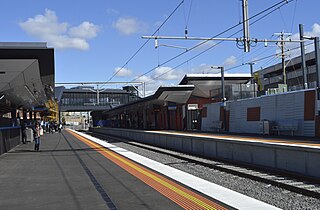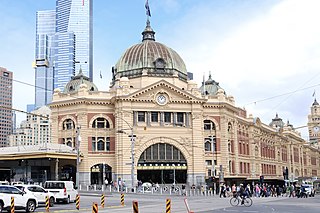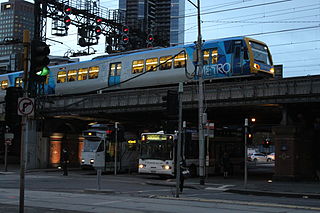The Public Transport Users Association (PTUA) is a community-based public transport lobby group in Victoria, Australia, based in Melbourne. It is run entirely by volunteers and has no full-time staff.
The Public Transport Users Association (PTUA) is a community-based public transport lobby group in Victoria, Australia, based in Melbourne. It is run entirely by volunteers and has no full-time staff.
The organisation was founded in 1976 as the Train Travellers Association, and became prominent after the controversial Lonie Report recommended huge freeway expansion and closure of most public passenger transport in the city.
The Association advocates a greater role for public transport and less dependence on the private car. Key PTUA policies include:
Of particular interest to the Association are potential extensions to Melbourne's metropolitan rail network, particularly lines to Doncaster, Rowville (via Monash University's Clayton Campus) and Melbourne Airport, the revitalisation of the bus network, including more routes being upgraded to SmartBus status, [1] and filling in so-called "tram missing links", by the construction of mostly minor extensions to the tram network that will ensure that routes terminate at nearby railway stations, bus routes and activity centres. [2]
The PTUA successfully campaigned for extended New Year's Day public transport hours in 2004, [3] and that has been continued by the state government in subsequent years. They also successfully lobbied for the extension of the 109 tram to Box Hill in Melbourne's east. [4] The association successfully pushed against the contentious idea to prohibit bikes on trains during rush hour in 2008, garnering substantial media attention. [5] The Association maintains a high media profile, publishes a regular newsletter for members, operates an office in Melbourne, and has a branch in Geelong [6] The Ballarat branch is dormant. [7]
The current president is Tony Morton, who succeeded Daniel Bowen in October 2012.

Footscray railway station is a commuter and regional railway station and the junction point for the Sunbury, Werribee and Williamstown lines and V/Line services to Ballarat, Bendigo and Geelong, part of the Metropolitan and Regional railway networks. It serves the western Melbourne suburb of Footscray in Victoria, Australia. Footscray is a ground level premium station, featuring six platforms, two island platform with two faces and two side platform, connected by an accessible overground concourse. It opened on 17 January 1859, with the current location provided in 1900 and station provided in 2014.

Proposals for expansion of the Melbourne rail network are commonly presented by political parties, government agencies, industry organisations and public transport advocacy groups. The extensions proposed take a variety of forms: electrification of existing routes to incorporate them into the suburban rail system; reconstruction of former passenger rail lines along pre-existing easements; entirely new routes intended to serve new areas with heavy rail or provide alternative routes in congested areas; or track amplification along existing routes to provide segregation of services. Other proposals are for the construction of new or relocated stations on existing lines, to provide improved access to public transport services.

The Mernda line is a commuter railway line on the Melbourne metropolitan railway network serving the city of Melbourne in Victoria, Australia. Operated by Metro Trains Melbourne, the line is coloured red and is one of the two lines that constitute the Clifton Hill group. It is the city's eighth longest metropolitan railway line at 33.1 kilometres (20.6 mi). The line runs from Flinders Street station in central Melbourne to Mernda station in the north, serving 29 stations via Clifton Hill, Reservoir, Epping, and South Morang.

The Werribee line is a commuter railway line in the city of Melbourne, Victoria, Australia. Operated by Metro Trains Melbourne, it is the city's ninth longest metropolitan railway line at 32.9 kilometres (20.4 mi).

The Williamstown line is a commuter railway line in the city of Melbourne, Victoria, Australia. Operated by Metro Trains Melbourne, it is the city's third shortest metropolitan railway line at 16.2 kilometres (10.1 mi).

The Melbourne rail network is a metropolitan suburban and freight rail system serving the city of Melbourne, Victoria, Australia. The metropolitan rail network is centred around the Melbourne central business district (CBD) and consists of 221 railway stations across 16 lines, which served a patronage of 182.5 million over the year 2023–2024. It is the core of the larger Victorian railway network, with regional links to both intrastate and interstate rail systems.

Victoria has the highest density of roads of any state in Australia. Unlike Australia's other mainland states, which have vast areas with virtually no residents, Victoria has population centres spread out over most of the state, with only the far north-west and the Victorian Alps without significant settlements. Population centres are linked by high quality highways and freeways. The state capital, Melbourne, has the most extensive freeway network of any city in Australia.

Transport in Melbourne, the state capital of Victoria, Australia, consists of several interlinking modes. Melbourne is a hub for intercity, intracity and regional travel. Road-based transport accounts for most trips across many parts of the city, facilitated by Australia's largest freeway network. Public transport, including the world's largest tram network, trains and buses, also forms a key part of the transport system. Other dominant modes include walking, cycling and commercial-passenger vehicle services such as taxis.

Transport in Sydney is provided by an extensive network of public transport operating modes including metro, train, bus, ferry and light rail, as well as an expansive network of roadways, cycleways and airports. According to the 2006 census, in terms of travel to work or study Sydney has the highest rate of public transport usage among the Australian capital cities of 26.3% with more than 80% of weekday trips to/from Central Sydney being made by public transport. According to the New South Wales State Plan, the state has Australia's largest public transport system. The public transport network is regulated by Transport for NSW.

Ballarat railway station is a regional railway station located on the Ararat line. It serves the city of Ballarat, Victoria, Australia, and opened on 11 April 1862 as Ballarat West. It was renamed Ballarat in 1865.

Myki, stylised as myki, is a reloadable credit card-sized contactless smart card ticketing system used for electronic payment of fares on most public transport services in Melbourne and regional Victoria, Australia. Myki replaced the Metcard ticketing system and became fully operational at the end of 2012.
The Transport Ticketing Authority (TTA) was a statutory authority within the Department of Transport in the State Government of Victoria, Australia. It was established in June 2003 to manage Victoria's interest in the OneLink Metcard public transport ticketing system contract, and to procure and manage the new ticketing system for Victoria, eventually known as myki.
The Victorian Transport Study, better known as the Lonie Report, was an extensive study of freight and passenger transport within the state of Victoria, Australia. The study was set up on 13 June 1979 by the Government of Victoria, and the report was published on 26 September 1980.

The earliest trams in Australia operated in the latter decades of the 19th century, hauled by horses or "steam tram motors". At the turn of the 20th century, propulsion almost universally turned to electrification, although cable trams lingered in Melbourne. In cities and towns that had trams, they were a major part of public transport assets.

The Doncaster railway line was a long-proposed suburban railway in the eastern suburbs of Melbourne, Victoria, Australia, that was anticipated to be built by the late 2020s, as a branch, along with the Hurstbridge line, of the planned future Clifton Hill Loop Line, as part of the 2013 PTV Network Development Plan.

The 1969 Melbourne Transportation Plan was a road and rail transport plan for Melbourne, the state capital of Victoria, Australia, instituted by Henry Bolte's state government. Most prominently, the plan recommended the provision of an extensive freeway network, much of which has since been built.

Trams in Ballarat were first used for public transport in 1887. They ceased to operate as a means of public transport in 1971, but a section continues to be operated today as a tourist attraction.
Numerous proposals have been made for improvements to the Melbourne tram network, the largest such network in the world. Nearly all of these have been for track extensions of existing lines to connect with nearby railway station or to service new areas and suburbs.

Night Network is Melbourne's weekend overnight public transport system, which commenced operation on 1 January 2016 for a 12-month trial, which was later extended by six-months, and made permanent in April 2017. It comprises all of Melbourne's regular electric railway lines, six tram lines, 21 night bus services, and five regional coach services. The night bus services replaced the previous NightRider services, with 10 operating radial from the CBD and the remaining 11 operating from suburban railway stations.

Rail Projects Victoria (RPV) was a project team of the Government of Victoria, Australia, responsible for the management of certain major infrastructure projects on the Victorian rail network, such as Metro Tunnel, Regional Rail Revival and Melbourne Airport Rail. Originally established as the Melbourne Metro Rail Authority (MMRA), to deliver the Melbourne Metro Rail Project, the office was later expanded in its responsibilities to include the management and planning of a number of major infrastructure programs on V/Line's regional rail services. In January 2019, it was renamed to RPV to reflect its expanded scope. It also ceased to be an independent office and became a project team within the Department of Transport and Planning's Major Transport Infrastructure Authority (MITA).